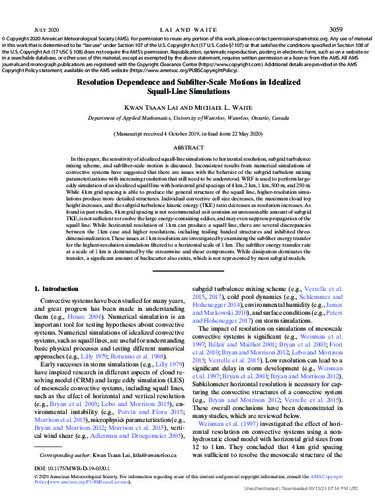| dc.contributor.author | Lai, Kwan Tsaan | |
| dc.contributor.author | Waite, Michael L | |
| dc.date.accessioned | 2021-10-19 19:52:40 (GMT) | |
| dc.date.available | 2021-10-19 19:52:40 (GMT) | |
| dc.date.issued | 2020-07-08 | |
| dc.identifier.uri | https://doi.org/10.1175/MWR-D-19-0330.1 | |
| dc.identifier.uri | http://hdl.handle.net/10012/17655 | |
| dc.description | © Copyright 2020 American Meteorological Society (AMS). For permission to reuse any portion of this work, please contact permissions@ametsoc.org. Any use of material in this work that is determined to be “fair use” under Section 107 of the U.S. Copyright Act (17 U.S. Code §?107) or that satisfies the conditions specified in Section 108 of the U.S. Copyright Act (17 USC § 108) does not require the AMS’s permission. Republication, systematic reproduction, posting in electronic form, such as on a website or in a searchable database, or other uses of this material, except as exempted by the above statement, requires written permission or a license from the AMS. All AMS journals and monograph publications are registered with the Copyright Clearance Center (https://www.copyright.com). Additional details are provided in the AMS Copyright Policy statement, available on the AMS website (https://www.ametsoc.org/PUBSCopyrightPolicy). | en |
| dc.description.abstract | In this paper, the sensitivity of idealized squall-line simulations to horizontal resolution, subgrid turbulence
mixing scheme, and subfilter-scale motion is discussed. Inconsistent results from numerical simulations of
convective systems have suggested that there are issues with the behavior of the subgrid turbulent mixing
parameterizations with increasing resolution that still need to be understood. WRF is used to perform large eddy simulation of an idealized squall line with horizontal grid spacings of 4 km, 2 km, 1 km, 500 m, and 250 m.
While 4 km grid spacing is able to produce the general structure of the squall line, higher-resolution simu lations produce more detailed structures. Individual convective cell size decreases, the maximum cloud top
height increases, and the subgrid turbulence kinetic energy (TKE) ratio decreases as resolution increases. As
found in past studies, 4 km grid spacing is not recommended as it contains an unreasonable amount of subgrid
TKE, is not sufficient to resolve the large energy-containing eddies, and may even suppress propagation of the
squall line. While horizontal resolution of 1 km can produce a squall line, there are several discrepancies
between the 1 km case and higher resolutions, including trailing banded structures and inhibited three dimensionalization. These issues at 1 km resolution are investigated by examining the subfilter energy transfer
for the highest-resolution simulation filtered to a horizontal scale of 1 km. The subfilter energy transfer rate
at a scale of 1 km is dominated by the streamwise and shear components. While dissipation dominates the
transfer, a significant amount of backscatter also exists, which is not represented by most subgrid models. | en |
| dc.description.sponsorship | Funder 1, Natural Sciences and Engineering Research Council of Canada (Grant RGPIN-386456-2015) || Funder 2, and the Canadian Foundation for Innovation. | en |
| dc.language.iso | en | en |
| dc.publisher | AMS | en |
| dc.relation.ispartofseries | Monthly Weather Review; | |
| dc.subject | Cloud resolving models | en |
| dc.subject | Parameterization | en |
| dc.subject | Subgrid-scale processes | en |
| dc.title | Resolution Dependence and Subfilter-Scale Motions in Idealized Squall-Line Simulations | en |
| dc.type | Article | en |
| dcterms.bibliographicCitation | Lai, K. T., & Waite, M. L. (2020). Resolution Dependence and Subfilter-Scale Motions in Idealized Squall-Line Simulations. Monthly Weather Review, 148(7), 3059–3078. https://doi.org/10.1175/MWR-D-19-0330.1 | en |
| uws.contributor.affiliation1 | Faculty of Mathematics | en |
| uws.contributor.affiliation2 | Applied Mathematics | en |
| uws.typeOfResource | Text | en |
| uws.peerReviewStatus | Reviewed | en |
| uws.scholarLevel | Faculty | en |

